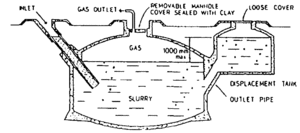Fixed dome digesters are one of the most well-known wet-fermentation biogas generators in the world. These simple, typically underground generators originated in China circa 1936.[1]

Due to their relative simplicity and use of readily available materials both as fuel and in construction, fixed dome digesters have become increasingly popular throughout the world. The typical structure of a fixed dome digester consists of an inlet trough, a lower fermenting reservoir with a rigid, immovable collection dome capping it, and some type of overflow relief. Several different types of fixed dome digesters exist, but by far the most popular is the Chinese design, which is typically built of gas-sealed brick and mortar or cement.
The simple design of a fixed-dome digester and its lack of moving parts means that if constructed well, the structure will last for many years. However, the design is by nature inaccessible due to its (usually) underground construction, and its lack of moving parts means that access to the interior of the digester (say for cleaning and maintenance purposes) is extremely difficult. Since the methane gas inside the collection chamber is being pushed out only by the pressure of other methane, the gas pressure coming out of the collector is subject to large fluctuations, making it unsuitable to use for cooking, or other applications requiring a steady stream of gas flow, without an additional regulating device.[2]
Pros[edit | edit source]
- Sturdy and possible to build from cheap, inexpensive materials
- Unobtrusive- typically buried.
- Well insulated. The underground design combined with typically porous building materials allows the biodigester to remain at a productive temperature for longer.
Cons[edit | edit source]
- Skilled bricklayers needed to construct a usable gas collection dome
- Entire structure must be airtight in order to keep collected methane from escaping
- Typically underground construction limits accessibility and repair
- If cold and not internally heated, insulated design increases time to produce methane each day
- Gas outlet subject to large pressure fluctuations
- Gas leaks become frequent as the structure ages
Comparisons to other digester types[edit | edit source]
- Similar gas output
- Poorer pressure consistency
- Easier to maintain (no corrosion)
- Much harder to gauge amount of gas available for use
- Typically less expensive
- Better insulated, option for internal heating
- Higher life expectancy
vs. Polyethelene Tube Digester
- Less versatile (harder to adapt structure for increased use)
- More expensive, materials more difficult to source
- Higher pressure gas outlet
- Higher life expectancy
- Less obtrusive
- Much more complicated, less suitable for experimental/trial operations
- Harder to maintain but more durable
Types of Fixed Dome Digesters[edit | edit source]
- Chinese fixed dome: The original. Some five million have been built in China since the 1930s.
- Janata model (obsolete): An Indian-built fixed-dome digester. Discontinued due to flawed construction methodology consistently leading to cracks in the gas-holding dome and subsequent leakage.
- Deenbanhdu model: Successor to the Janata model, simplifies the silo-shape of the Chinese fixed dome fermentation chamber/gas collector down to a hemispherical dome.
- CAMARTEC: Simplest design of the fixed-dome digesters. Hemispherical fermentation chamber/gas collector with a rigid base.[3]